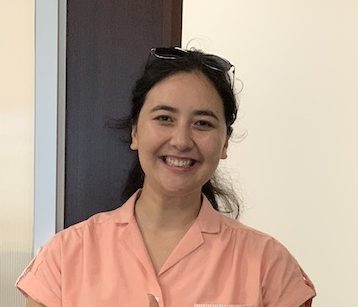Women in 3D Printing: Meet Sarah Wolff
20
July, 2021

Paul Cesak

Sarah Wolff
I recently got to sit down with Sarah Wolff at Texas A and M and we discussed her career and her involvement with 3D Printing. She is an Assistant Professor. I really had a great time and enjoyed getting to know her better.
Paul Cesak
I am here with Sarah Wolff at Texas A&M and Sarah has recently been inducted into “Women in 3D Printing”.
Paul
Please give me a short description of your background and when did you first decide you liked 3D printing? Was it an Ah-ha moment?
Sarah
Yes…so my undergrad was in environmental engineering…I liked working with water and air pollution, but while doing my undergrad in environmental engineering I was able to do co-ops at GE Aviation in the Cincinnati OH area. While I was there, I was exposed to their shop floors where they were assembling and building their huge jet engines and I decided I like the manufacturing side better.
That is where I think…that was my ah-ha moment. But for 3D printing at GE, at the time, this was around 2010 or 2011, they were starting to test and build polymer prototypes of a lot of their engine parts and when I saw that, I thought that was the coolest thing ever. So, I transitioned from doing rotations in air pollution and wastewater cleaning to more of the manufacturing side of the parts as well as pneumatic testing of their airfoils or their manifolds, and it was so cool because I got to actually test the polymer 3D printed prototypes of these manifolds and airfoils.
That really got me interested.
When I got ready to go back to school, I decided I was going to change to mechanical engineering. I got my degree in environmental engineering because I was already kind of close to graduation but then I decided to do a Master’s in mechanical engineering and then finally after that…do a Ph.D. in mechanical engineering. Then, in the beginning, I thought my graduate research projects would be in laser surface texturing or laser machining, but that quickly morphed into laser metal printing, and I have not looked back since.
It is such a cool process, just melting of metal powders with the laser and playing around lasers, so that is how I got into it. Since I went back to grad school, GE has just exploded into the additive manufacturing game, especially with metals. They were doing more polymers when I was there. They were just starting some of the metals research and now they have their own additive manufacturing division.
Paul
Second question…Additive Manufacturing or 3D Printing; inquiring minds need to know.
Sarah
I would say both work and I think it depends on the context. So, with additive manufacturing, because it is manufacturing, you have room for subtractive manufacturing hybrid and it kind of fits in our manufacturing concentration, so additive manufacturing fits nicely into that as well as any kind of hybrid or subtractive and I think it just allows room for any type of advanced processing or advanced manufacturing; anything that has to do with manufacturing.
But I also really like 3D Printing because it is a more accessible term and it is a good term for outreach, especially for kids or for people who do not know much about manufacturing or have this idea that manufacturing is just a factory. But 3D Printing is a lot more accessible because you can 3D print at home, you can 3D Print at school, you can design; I think 3D Printing has more of a design type of connotation to it; so, I would say both. I think it depends on the context because 3D Printing also captures the imagination as we were talking about earlier. That is how you get people roped in.
Paul
What is an average day for you here at Texas A&M look like?
Sarah
As a professor, I am relatively new and we have three main responsibilities; first, there’s teaching, then there’s service, but the biggest responsibility, as a professor, is the research. I will go a little bit into each type of aspect.
For teaching, I teach undergrads and hopefully, later, I will also be able to teach graduate students. I will teach up to 100 undergrads per semester and the main class that I teach is called Essentials of Modern Manufacturing and Engineering Design. Essentially, it is a kind of intro to manufacturing class for sophomores and juniors and in this class, I’ll give lectures on the theory side of design and manufacturing. First, we go over material properties as well as design concepts and students will learn how to use SolidWorks or any kind of computer-aided design software. Then we go into mechanical testing and mechanical properties, and then the second half of the course is going over all the manufacturing processes or at least trying to go over as many as possible.
The students will also do labs like milling, and casting, 3D printing, as well as a little bit of robotics. Last, they will do a final project by the end of the semester where they are in groups, and they’ll actually design and build some kind of robot where all the parts have to be manufactured by the students or made by the students. Then they must assemble it and control it with Arduino’s or something similar.
Service in the university and the department, as well as any outreach in the community, will include being on committees. We are building a Data engineering and data science undergrad program in our department so that is also designing this program and meeting with other professors. We also have this new group called women in industrial systems engineering. So, it is sponsoring these underground groups or a group of both undergrads and graduate women. And working with the local community and local industries and trying to host summer camps or host webinars.
The biggest responsibility is the research side. This is most of my day where I do a lot of writing and meeting with students who are composed of Ph.D. students, masters’ students, and undergraduate students, who want to do research. For the writing side, I will work on journal papers, research papers, and proposal writing, so I can get funding to keep doing research.
But the fun part is the mentoring and interacting with students both in the classroom, for the teaching side, but also for research. And these students who are working in the lab, they want to explore new types of concepts or run experiments. And we will talk about what we are learning from the experiments or how to design the next batch of experiments. Or what kind of research questions do we need to ask.
For example, if we see videos like strange phenomena of bubbles coalescing in the process, we need to ask ourselves why is this happening? And then, do a deep dive into what are all the physics that are happening when you melt metal, and then it solidifies so quickly…why would that lead to bubbles coalescing and make bigger bubbles. So, I would say that is definitely the most challenging part intellectually. But it is also the most stimulating and the most fun.
.



























0 Comments